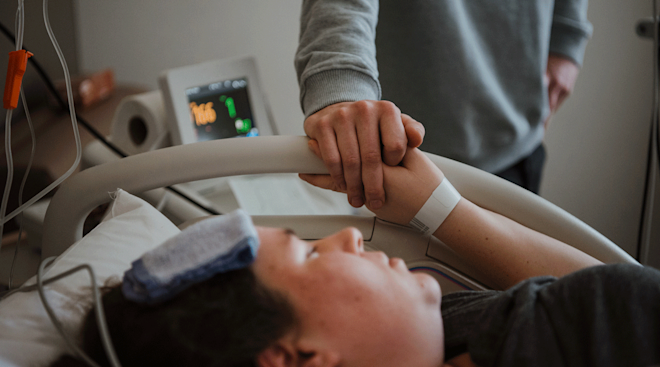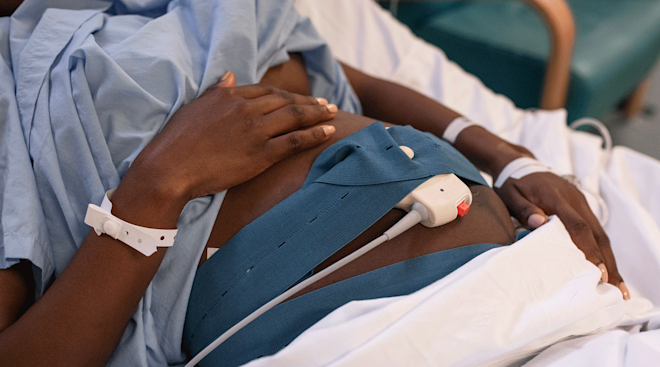What to Know About Forceps Delivery
In a perfect world, baby would effortlessly slide out during labor and delivery. In reality, they often need a little help making their grand entrance. If the pace of your vaginal delivery stalls or doctors need to get baby out ASAP, they may recommend a forceps delivery. If you think using forceps sounds old-fashioned (and scary), you’re not alone—but doctors say this delivery method is still helpful and necessary in certain situations. Here’s everything you need to know about a forceps delivery, including situations when your doctor may recommend it, as well as potential forceps delivery risks to Mom and baby.
Forceps are among the standard obstetrical tools sometimes used to assist delivery. There are different types of forceps (see below), but they all have handles and two large ends that kind of look like salad tongs or spoons, and are designed to reach up through the birth canal to grip the sides of baby’s head. “They’re used to benefit both Mom and baby,” says Michael Cackovic, MD, a maternal-fetal medicine physician at the Ohio State University Wexner Medical Center.
A forceps delivery is when your OB uses forceps to help get baby out during a vaginal delivery. “[The forceps] gently grasp the baby’s head, helping the physician guide the baby through the birth canal for a safe delivery,” explains Heather Beall, MD, an ob-gyn at Northwestern Medicine Huntley Hospital in McHenry County, Illinois.
The forceps are often used during a contraction while Mom pushes. “We’re not really pulling the baby as much as we are pulling your tissues away from the baby so that you can push more easily,” Cackovic says.
Types of forceps used in delivery
There are several types of forceps that can be used to assist delivery, and each is slightly different. These are the most common:
Elliot forceps. These forceps have rounder ends. They “resemble large salad tongs with overlapping shanks and are used when the baby’s head is round,” Beall says.
Simpson forceps. Simpson forceps are longer and “are best when the baby’s head has been molded and elongated by the mother’s birth canal,” Beall says.
Kielland forceps. These forceps have less of a curve. They “help a physician rotate a baby without causing injury to the vagina,” Beall says.
The good news: Forceps delivery is not incredibly common. According to the American College of Obstetricians and Gynecologists (ACOG), “operative vaginal births,” which include the use of forceps or a vacuum (a cup-like tool, featuring a handle and pump, that gently suctions to baby’s head), made up just 3.3 percent of births in 2013. “Over the years, the incidence of using forceps to get a baby out has decreased,” says Christine Greves, MD, an ob-gyn at the Winnie Palmer Hospital for Women & Babies in Orlando, Florida. “We’re using a vacuum more often or women are having a c-section.”
Still, there are situations where a forceps delivery is the best option. “You use forceps when you need to expedite delivery,” says David Colombo, MD, a maternal-fetal medicine physician at Spectrum Health in Grand Rapids, Michigan. Usually, he says, forceps may be used if there’s fetal distress, the baby’s heart rate drops or doctors don’t think you’d be able to push baby out as quickly as needed. If the mother is exhausted and can’t push anymore, forceps may also come in handy, he adds. “Forceps can help deliver the baby for the last inch or so.”
First, your doctor should explain the reason for wanting to use the forceps. Next, your bladder will be emptied via a catheter. “That way, there is more room in the vagina for the forceps,” Greves explains.
Finally, your doctor will slide the forceps around baby’s head to gently guide them through the birth canal during contractions, Beall says.
“I always tell patients, if the forceps go on easy, it’s a go,” Cackovic says. “If we’re struggling to get them on, we don’t do it.” Ultimately, “the baby should come out within three sets of pushes.”
“In the right hands, forceps are very safe,” Cackovic says. While major forceps delivery complications are unlikely, there are a few small possible risks to you and baby. It’s a trade-off. “Forceps can lower the risk of c-section and help when there’s concern that we need to get the baby out more quickly or if the mom is exhausted,” explains Greves.
Forceps delivery risks for the mother
Many of the risks of forceps delivery are also risks in any vaginal delivery, Beall says. Those can include:
- Vaginal pain after delivery
- Anal pain after delivery
- Tears or wounds in the genitals
- Weakness in the bladder and pelvic muscles after delivery
While it’s true that these injuries may also accompany an unassisted vaginal birth, according to the Mayo Clinic, they’re slightly more likely among women who have had a forceps delivery. Additionally, in some instances, you may need an episiotomy, an incision in the perineum, before the forceps are inserted.
It’s also worth noting that if a forceps delivery is unsuccessful, a c-section may be necessary.
Forceps delivery risks for baby
“Most babies are just fine after a forceps delivery,” Beall says. However, there are some possible risks to forceps birth, Cackovic says, including:
- Bruising
- Forceps delivery marks
- Temporary swelling
Forceps delivery marks and other minor telltale signs of forceps birth “usually go away within 24 hours,” Cackovic says.
More serious injuries, which can include temporary nerve loss and bleeding, “are uncommon,” Beall emphasizes—especially at the hand of a skilled operator.
It’s normal to be nervous, but don’t worry too much about forceps delivery complications. The truth is that you’ll probably experience discomfort regardless of whether your vaginal birth is assisted with tools or not. The ultimate goal is a safe delivery and healthy baby, and forceps are sometimes the best way to achieve this.
Recovery after a forceps delivery is “exactly the same as recovery for a vaginal birth,” Colombo says. “If there’s a tear, we repair that, but somebody can tear their vagina during a normal vaginal birth too.” In other words, a forceps delivery won’t necessarily require extra healing time.
No one wants a forceps birth, but it may be unavoidable. Doctors stress that there are simply some situations where forceps are needed for a healthy delivery. Still, Beall says, “The best thing a woman can do to prepare for delivery is to have a healthy pregnancy.” That means exercising regularly and trying to stay within the recommendations for weight gain “so your body is strong and prepared for the rigor of delivering a baby,” she says.
Beall also suggests taking a childbirth class to understand more about the process of birthing a baby. “No two labors are the same, and we can’t control every element of a delivery,” she says. “The important thing is to ask a trusted physician questions about labor and delivery, so you feel as informed as possible when the day finally arrives.”
About the experts:
Heather Beall, MD, is an ob-gyn at Northwestern Medicine Huntley Hospital in McHenry County, Illinois. She received her medical degree at the University of Illinois at Chicago College of Medicine.
Michael Cackovic, MD, is a maternal-fetal medicine physician at the Ohio State University Wexner Medical Center. He received his medical degree at the MCP Hahnemann University College of Medicine.
David Colombo, MD, is a maternal-fetal medicine physician at Spectrum Health in Grand Rapids, Michigan. He received his medical degree from Ohio State University.
Christine Greves, MD, is an ob-gyn at the Winnie Palmer Hospital for Women & Babies in Orlando, Florida. She received her medical degree from the University of South Florida.
Please note: The Bump and the materials and information it contains are not intended to, and do not constitute, medical or other health advice or diagnosis and should not be used as such. You should always consult with a qualified physician or health professional about your specific circumstances.
Plus, more from The Bump:
Navigate forward to interact with the calendar and select a date. Press the question mark key to get the keyboard shortcuts for changing dates.




















































